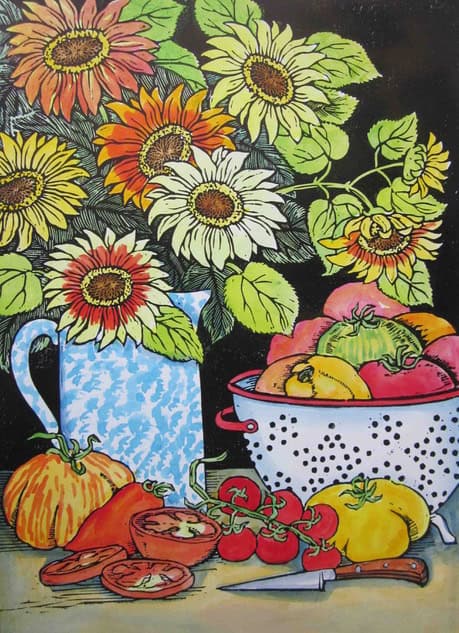 The Color Wheel Garden: Growing the Best Nutritional Varieties
The Color Wheel Garden: Growing the Best Nutritional Varieties
Flavor and optimum health go hand in hand when growing a garden, yet knowing what varieties to choose for higher antioxidant qualities can influence what you plant. Science has shown that color—deep purple, blue, orange, and red—vegetables and fruits contain the highest phytonutrients, flavonoids, resveratrol, and anthocyanins than paler colors. Plant open-hearted lettuces, bitter chicories, purple tomatoes, and red onions to change up your ordinary garden plan, with the result of adding better nutrition flavor to your diet.
The Color Wheel Garden is one of the designs from from my upcoming new book The New Heirloom Garden, (Rodale 2020) featuring the most colorful varieties of fruits and vegetables that also contain the highest nutritional properties. Deeply-colored edibles most closely resemble their original wild counterparts, in part, because they have not been overly bred to change their inherent qualities. These native plants offer the gardener a visually stunning garden, while serving up the healthiest options.
Inspiration:
Plant breeding, both by natural selection and in a lab, has been dictating what we eat for thousands of years. What’s left behind for us to eat, or grow, or buy in a supermarket is a narrow selection compared to the genetic heritage that every edible plant contains. While not all of us can or want to be foragers, we can choose to plant our gardens with species that closely resemble the earliest cultivars to experience rich flavors, deep colors, and healthier selections that were once plentiful in the wild.
Stop pulling weeds in favor of cultivating purslane, dandelion, and chickweed, all ancient greens that grow readily in our gardens with far more vitamin E than cultivated spinach, four times more omega-3 fatty acids than lettuce, and seven times more beta-carotene than carrots, plus high levels of iron and calcium. Blue potatoes, originally discovered in the Andes, contain more minerals and nutrients than an Irish spud. Choose to grow tiny Red Currant tomatoes, which may make your mouth pucker, yet the diminutive size and deep color are closer to its native cousin than a large, modern sweet beefsteak.
5 Tips for Growing: The Color Wheel Garden
Plant Appreciation: Choose richly hued fruits and vegetables that contain anthocyanins, associated with better heart health, blood pressure, and obesity. Science suggests that choosing purple, blue, orange vegetables and fruits are better for our health, yet make up only 3 percent of the average American’s diet.
Variations on the Theme: Plan to stagger height and color throughout the garden by grouping plants based on size and days to maturity. Grow nasturtiums under broccoli or cabbage next to onions, making the most of the high-low areas of the garden.
High Impact: Mass plantings are robust and make the garden easier to maintain by concentrating plants that require similar amounts of sun or shade, water and fertilizer together. It also makes them easier to harvest at the end of the season.
Throw in Curves: Build waves of color into the design and give your garden a more elegant feel by planting with curves and arcs. It takes a little advance planning on paper first, then staking out the garden, but once the seedlings start coming up and the color builds, you’ll be delighted.
Mix it Up: Pollinators love diversity, so plan to add a range of their favorites planted in large blocks to give them a place to lay eggs and larvae to keep your garden naturally healthy and pest-free.
Below is an outline of The Color Wheel Garden from my book. Copy and color it in with your garden plan for 2019, or download my planting scheme with this PDF: Color Wheel Garden design preview from The New Heirloom Garden.



